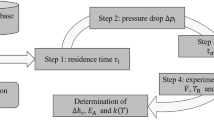Abstract
Classical thermo-analytical micro methods (DTA, DSC) are still very useful for process work, but medium scale instruments based on heat flow measurement are attaining an increasingly important role in this domain.
As in many areas, development of reaction calorimetry for industrial applications was driven by needs and by available means (technical capabilities).
The needs have been fairly constant over the past decades. There are data needs:
-
Reaction rates
-
Heat release rates
-
Heat of desired reactions and decompositions
-
Heat capacities and heat transfer capacities
It took the specialists of calorimetry a long time to recognize and to accept the operational needs, namely:
-
Working under controlled temperature conditions (constant temperature, temperature ramps)
-
Adding components during runs (continuously or in portions)
-
Simulation of industrial mixing conditions
The main driving force for the development of process oriented calorimetric instruments was the evolution of electronic hardware which made the control of heat flow on a (non micro) laboratory scale easy.
The paper gives an overview on the principles of heat flow control and reviews the developments of the fifties and sixties, when the matching of heat flow with heat release by reactions was the goal.
With the advent of fast and powerful laptop computers, the focus has shifted. Now, the deduction of true heat release rates from signals which may be badly distorted, is the goal.
Some recent developments are reviewed and the hope is expressed that calorimetric equipment, inexpensive enough to be affordable for every laboratory engaged in process work, will be available soon.
Similar content being viewed by others
References
W. Hemminger and G. Höhne, Calorimetry, Verlag Chemie, 1984.
W. Regenass, Thermochim. Acta, 20 (1977) 65.
S. Igarashi and S. Katayama, Europ. Polymer J., 15 (1979) 805.
J. K. Gimzewski, Ch. Gerber, E. Meyer and R. R. Schiittier, Chem. Physics Letters, 217 (1994) 594.
M. Tian, Bull. Soc. Chim. France, 33 (1923)427.
E. Calvet and H. Prat, 1956, “Microcalorimétrie”, Masson, Paris.
H. J. Borchard and F. Daniels, J. Am. Chem. Soc., 79 (1957) 41.
H. E. Kissinger, Anal. Chem., 29 (1957) 1702.
R. N. Rogers and L. C. Smith, Thermochim. Acta, 1 (1970) 1.
F. Becker and W. Walisch, Z.phys. Chem. N. F., 46 (1965) 279.
P. Baumgartner and P. Duhaut, Bull. Soc. Chim. France, 1960, 1178.
H. M. Andersen, J. Polym. Sci. A-1, 4 (1966) 783; 7 (1969) 2889.
W. Köhler, O. Riedel and H. Scherer, Chem. Ing. Techn., 44 (1972) 1216; 45 (1973) 1289.
J. F. Chandler, Duxford (UK), personal communication.
B. Hentschel, Chem. Ing. Techn., MS 725 (1979).
J. Schildknecht, Thermochim. Acta, 49 (1981) 87.
W. Lite, J. Thermal Anal., 27 (1983) 215.
M. R. Meeks, Polym. Engng. Sci., 9 (1969) 141.
W. Regenass, Colloquium of the Working Party on Chemical Reaction Engineering (body of EFCE), Pont à Mousson (F), 1966 (first public presentation, no printed proceedings).
W. Regenass, W. Gautschi, H. Martin and M. Brenner, Thermal Analysis, ICTA 1974, Vol. 3, 823.
W. Regenass, ACS Symp. Ser., 65 (1978) 37.
G. Giger, A. Aichert and W. Regenass, Swiss Chem., 4 (1982)/3a, 33.
L. Hub, Ph. D. Thesis 5577, ETH Zürich, 1975.
L. Hub, Chem. Ing. Techn., 54 (1982) MS 978/82.
Mettler-Toledo AG, CH 8603 Schwerzenbach.
A. Küssner, Chem. Ing. Techn., 61 (1989) MS 1778/89.
H. Nilsson, C. Silvegren and B. Tornell, Chimia Scripta, 19 (1982) 164.
O. M. Eigenberger, Development of a laboratory fermenter-calorimeter, in: “Biochemical Engineering”, G. Fischer Ed., Stuttgart 1991, p. 352–356.
T. Stockhausen, J. Prüss and H. U. Moritz, Polymer Reaction Engineering, 127 (1992) 341.
A. Tietze, A. Pross, K. H. Reichert, Chem. Ing. Techn., 68 (1996) 97.
F. Becker, Chem. Ing. Techn., 40 (1968) 933.
W. Regenass, Chimia, 37 (1983) 430.
W. Regenass, Thermochim. Acta., 95 (1985) 351.
L. G. Karben and J. Villadsen, Chem. Eng. Sci., 42 (1987) 1153.
H. U. Moritz, in: “Praxis der Sicherheitstechnik” Dechema, Frankfurt 1995, p. 149–173.
J. Steinbach, “Chemische Sicherheitstechnik”, Verlag Chemie, 1995, p. 198–208.
W. Regenass, Chimia, 25 (1971) 154.
H. Martin, Ph. D. Thesis, U. of Basel, 1975.
W. Gautschi, Ph. D. Thesis, 5652, ETH Zürich, 1976.
W. Kanert, Ph. D. Thesis, U. of Basel, 1977.
M. Bürli, Ph. D. Thesis 6479, ETH Zürich, 1979.
J. Beyrich, Ph. D. Thesis, 6578, ETH Zürich, 1980.
Systag System Technik AG, CH 8803 Rüschlikon.
L. G. Karlsen, H. Sjøberg and J. Villadsen, Thermochim. Acta, 72 (1984) 83.
L. G. Karlsen, J. Villadsen, Chem. Eng. Sci., 42 (1987) 1165.
Author information
Authors and Affiliations
Additional information
In the English literature, the two expressions “heat flux” and “heat flow” are used. As we are generally not interested in flux (=flow per unit area), “heat flow” is preferred here.
Rights and permissions
About this article
Cite this article
Regenass, W. The development of heat flow calorimetry as a tool for process optimization and process safety. Journal of Thermal Analysis 49, 1661–1675 (1997). https://doi.org/10.1007/BF01983727
Issue Date:
DOI: https://doi.org/10.1007/BF01983727




